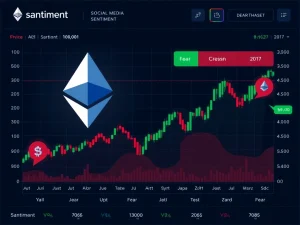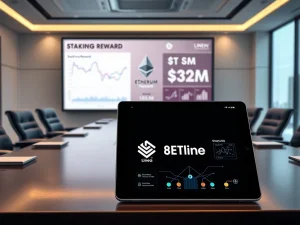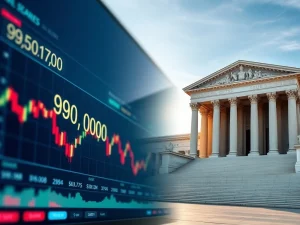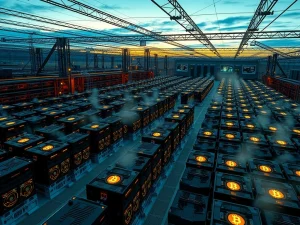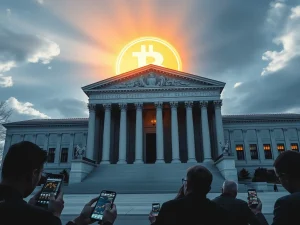SparkDEX Unleashes Explosive DeFi Growth: $SPRK Token Launch Propels Flare Network TVL to $134M
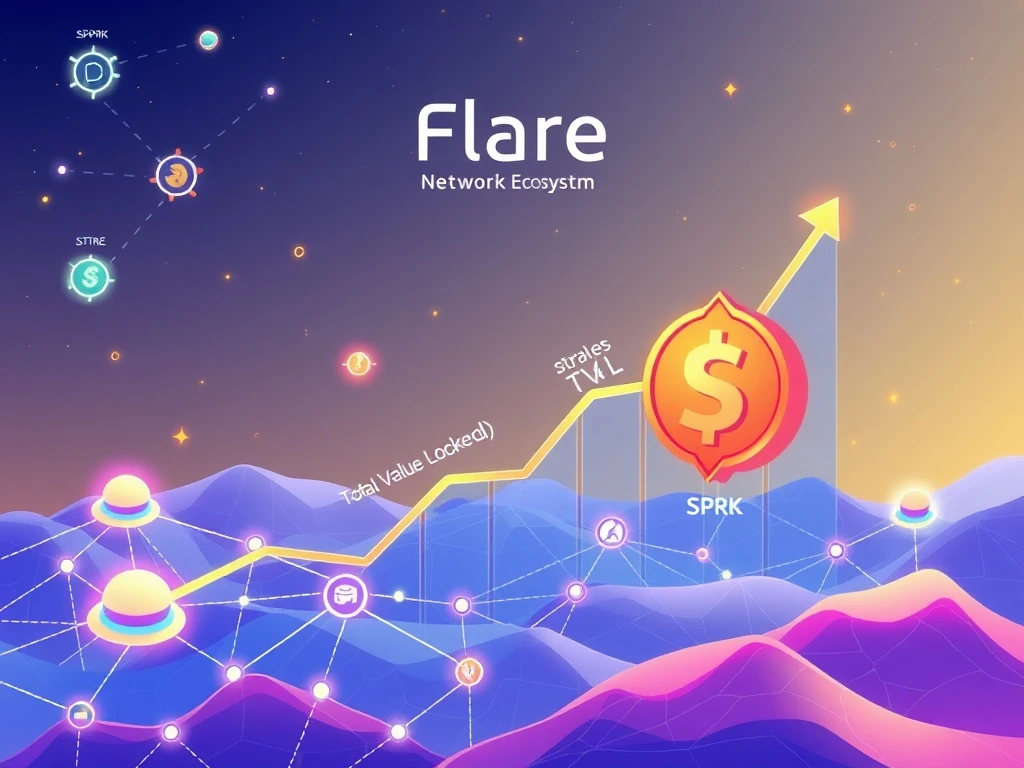
The decentralized finance (DeFi) landscape is constantly evolving, with new platforms and innovations emerging to reshape how we interact with digital assets. Today, all eyes are on the Flare Network, a blockchain designed for secure and scalable data, as its flagship decentralized exchange (DEX), SparkDEX, prepares for a momentous launch. The anticipation is palpable following a staggering 650% surge in SparkDEX’s Total Value Locked (TVL), signaling a new era of DeFi growth. This isn=”” t just another token launch; it’s a pivotal moment for cross-chain interoperability and institutional adoption within the broader crypto ecosystem. Let’s dive into the details of this exciting development.
SparkDEX: Igniting DeFi on Flare Network
At the heart of Flare’s burgeoning DeFi ecosystem lies SparkDEX, a decentralized exchange that has rapidly ascended to prominence. Recent months have seen an extraordinary surge in SparkDEX’s Total Value Locked (TVL), skyrocketing by an impressive 650% to reach a remarkable $134 million. This exponential growth firmly establishes SparkDEX as a central and indispensable platform within the Flare network’s DeFi landscape. The excitement surrounding SparkDEX is now reaching a crescendo with the imminent release of its native token, the $SPRK token, slated for a late July 2025 launch via Flarepad. This strategic move is designed to empower the community through enhanced governance capabilities and to incentivize crucial liquidity, aligning seamlessly with Flare’s overarching vision for increased decentralization and robust cross-chain functionality. The success of SparkDEX is a testament to Flare’s innovative approach to DeFi, paving the way for more sophisticated financial applications.
How Flare Network is Building a Cross-Chain DeFi Powerhouse
The Flare Network is not merely a blockchain; it’s an ambitious project aiming to bridge disparate crypto ecosystems, particularly focusing on bringing utility to non-smart contract tokens like XRP. Its foundational technology, the State Connector, is a game-changer, enabling secure and decentralized cross-chain interoperability. This allows data and assets from other blockchains to be used on Flare without compromising security. Furthermore, the Flare Time Series Oracle (FTSO) plays a critical role in maintaining the network’s integrity by incentivizing data providers to submit accurate price information. This robust oracle system is vital for DeFi applications, ensuring reliable and sustainable tokenomics. The network’s strategic integration with the XRPFi suite, which facilitates XRP staking and lending, has been a significant catalyst for adoption. This, coupled with key institutional partnerships and ongoing interoperability initiatives, has propelled Flare’s overall ecosystem growth, pushing its Total Value Locked (TVL) to an impressive $134 million and attracting 482,000 active addresses. Flare’s infrastructure is clearly designed for large-scale, secure, and interconnected DeFi operations.
XRP’s Expanding Utility: A Game-Changer on Flare
For enthusiasts following XRP News, Flare Network represents a significant leap forward in expanding XRP’s utility beyond traditional payment rails. The integration of Flare’s XRPFi suite has unlocked new possibilities for XRP holders, allowing them to participate in on-chain lending and staking. This move is crucial for XRP, as it enables the asset to become a more dynamic and integral part of the decentralized finance landscape. A prime example of this expanding utility is SparkDEX’s collaboration with Uphold, a leading multi-asset digital money platform, to launch XRPFi. This partnership has created seamless avenues for XRP users to engage with DeFi protocols, enhancing liquidity and accessibility. Moreover, institutional confidence in Flare’s ability to integrate traditional finance (TradFi) capital into its decentralized infrastructure is evident. The notable $100 million XRP deployment with VivoPower underscores the potential for significant capital inflows and showcases Flare’s capability to bridge the gap between traditional finance and decentralized applications. This ongoing expansion of XRP’s utility on Flare is not just a technical achievement but a strategic move to unlock greater value for the XRP community.
The $SPRK Token: Fueling Governance and Liquidity
The upcoming launch of the $SPRK token is more than just a new digital asset; it’s a strategic move designed to decentralize control and incentivize participation within the SparkDEX ecosystem. As SparkDEX’s native governance token, $SPRK will empower its holders to have a direct say in the platform’s future development, including protocol upgrades, fee structures, and new feature implementations. This shift towards community-led governance is a cornerstone of true decentralization. Beyond governance, the $SPRK token will play a crucial role in providing liquidity incentives, encouraging users to contribute to SparkDEX’s liquidity pools. This mechanism is vital for maintaining deep liquidity, ensuring efficient trading, and attracting more users to the platform. Analysts widely view SparkDEX’s tokenization strategy as a significant catalyst for further DeFi expansion on Flare. By aligning the interests of users, developers, and the community, $SPRK aims to foster a vibrant, self-sustaining ecosystem that continues to drive innovation and growth on the Flare Network.
Navigating DeFi Growth: $FLR’s Trajectory and Market Outlook
The overall DeFi growth on the Flare Network has been bolstered by several key developments attracting significant capital and institutional interest. The recent adoption of Tether’s omnichannel USD₮0, for instance, has already generated over $60 million in minting volume, demonstrating the network’s capacity to handle substantial stablecoin activity. Furthermore, BitGo’s robust custody solutions have played a pivotal role in attracting institutional participation, particularly in Flare’s native tokens, including $FLR and Songbird’s $SGB. This institutional confidence is a strong indicator of Flare’s long-term viability and potential. However, despite these impressive advancements and positive ecosystem news, the $FLR token has experienced some selling pressure after reaching a six-month high. Technical indicators reflect this cautious investor behavior: the Relative Strength Index (RSI) has slightly declined to 63 from 70, and the MACD histogram has flattened. While this suggests temporary profit-taking, historical support zones around $0.0220–$0.0230 may offer stability if the current downward momentum persists. Analysts remain optimistic about Flare’s long-term fundamentals, citing strong institutional partnerships and continuous DeFi innovation as key drivers for future growth, even as short-term market volatility persists.
A Bright Future for Flare’s DeFi Ecosystem
The launch of the $SPRK token marks a critical milestone for Flare’s burgeoning DeFi ecosystem. With SparkDEX leading the charge, supported by Flare’s robust infrastructure and strategic integrations, the network is exceptionally well-positioned to capitalize on the surging global demand for decentralized financial tools. The synergy between SparkDEX, the Flare Network’s innovative State Connector and FTSO technologies, and the expanding utility of XRP through XRPFi creates a compelling narrative for sustained growth. While the short-term trajectory of $FLR may be subject to broader market volatility, the underlying fundamentals, bolstered by increasing institutional confidence and strategic partnerships, paint a promising long-term picture. Flare is not just building a platform; it’s cultivating a comprehensive, interconnected DeFi environment designed for the future of finance.
Frequently Asked Questions (FAQs)
1. What is SparkDEX and what is the $SPRK token?
SparkDEX is the flagship decentralized exchange (DEX) built on the Flare Network. It facilitates decentralized trading and liquidity provision. The $SPRK token is its native cryptocurrency, designed to enhance governance within the SparkDEX ecosystem and provide liquidity incentives to users, aligning with Flare’s decentralization goals.
2. What is the Flare Network and its significance in DeFi?
The Flare Network is a high-performance, EVM-compatible blockchain focused on secure cross-chain interoperability. Its significance in DeFi stems from its ability to bring smart contract functionality to non-smart contract cryptocurrencies like XRP via its State Connector technology, and to provide reliable price data through its Flare Time Series Oracle (FTSO). This enables a broader range of assets to participate in DeFi.
3. How does XRP integrate with the Flare ecosystem?
XRP integrates with the Flare ecosystem primarily through the XRPFi suite, which allows XRP holders to stake and lend their XRP on-chain. This expands XRP’s utility beyond payments, enabling it to participate actively in decentralized finance applications. Collaborations with platforms like Uphold further facilitate this integration.
4. What is the current outlook for the $FLR token?
The $FLR token, Flare Network’s native asset, has seen significant growth but recently experienced some short-term selling pressure after reaching a six-month high. While technical indicators suggest temporary profit-taking, analysts remain optimistic about its long-term potential due to strong fundamentals, including institutional partnerships, increasing DeFi adoption on Flare, and continuous ecosystem development.
5. What are Flare’s key technologies supporting its growth?
Flare’s growth is underpinned by two core technologies: the State Connector and the Flare Time Series Oracle (FTSO). The State Connector securely brings data from other blockchains onto Flare, enabling cross-chain interoperability. The FTSO provides decentralized and accurate price data to DeFi applications, ensuring the reliability and sustainability of the network’s tokenomics.

